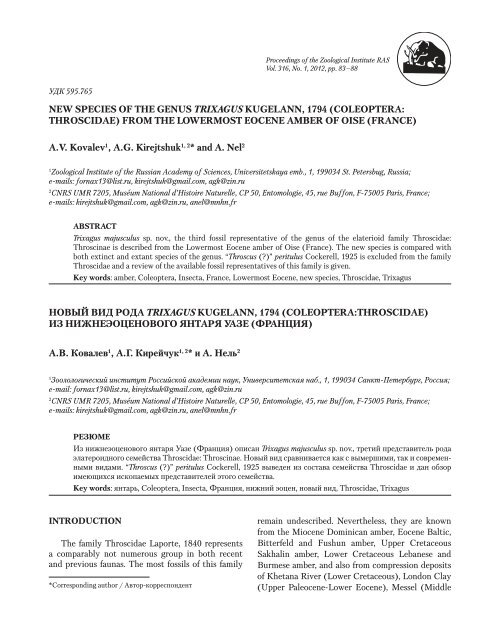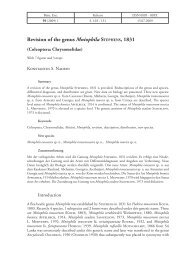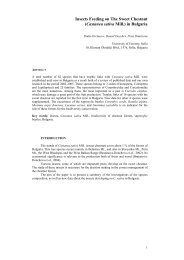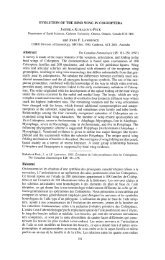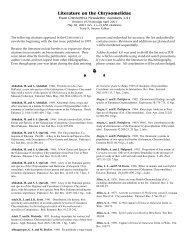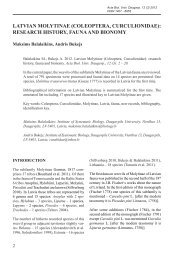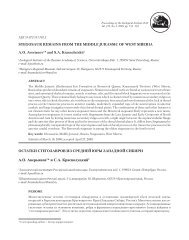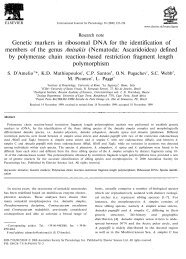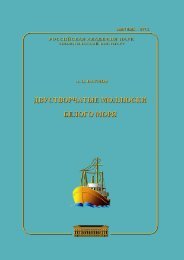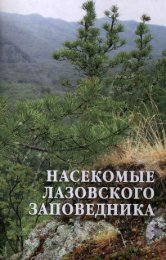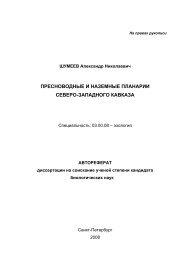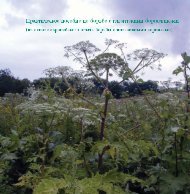New species of the genus Trixagus Kugelann, 1794 (Coleoptera ...
New species of the genus Trixagus Kugelann, 1794 (Coleoptera ...
New species of the genus Trixagus Kugelann, 1794 (Coleoptera ...
- No tags were found...
You also want an ePaper? Increase the reach of your titles
YUMPU automatically turns print PDFs into web optimized ePapers that Google loves.
Proceedings <strong>of</strong> <strong>the</strong> Zoological Institute RASVol. 316, No. 1, 2012, рр. 83–88УДК 595.765NEW SPECIES OF THE GENUS TRIXAGUS KUGELANN, <strong>1794</strong> (COLEOPTERA:THROSCIDAE) FROM THE LOWERMOST EOCENE AMBER OF OISE (FRANCE)A.V. Kovalev 1 , A.G. Kirejtshuk 1, 2 * and A. Nel 21Zoological Institute <strong>of</strong> <strong>the</strong> Russian Academy <strong>of</strong> Sciences, Universitetskaya emb., 1, 199034 St. Petersbug, Russia;e-mails: fornax13@list.ru, kirejtshuk@gmail.com, agk@zin.ru2CNRS UMR 7205, Muséum National d’Histoire Naturelle, CP 50, Entomologie, 45, rue Buffon, F-75005 Paris, France;e-mails: kirejtshuk@gmail.com, agk@zin.ru, anel@mnhn.frABSTRACT<strong>Trixagus</strong> majusculus sp. nov., <strong>the</strong> third fossil representative <strong>of</strong> <strong>the</strong> <strong>genus</strong> <strong>of</strong> <strong>the</strong> elaterioid family Throscidae:Throscinae is described from <strong>the</strong> Lowermost Eocene amber <strong>of</strong> Oise (France). The new <strong>species</strong> is compared withboth extinct and extant <strong>species</strong> <strong>of</strong> <strong>the</strong> <strong>genus</strong>. “Throscus (?)” peritulus Cockerell, 1925 is excluded from <strong>the</strong> familyThroscidae and a review <strong>of</strong> <strong>the</strong> available fossil representatives <strong>of</strong> this family is given.Key words: amber, <strong>Coleoptera</strong>, Insecta, France, Lowermost Eocene, new <strong>species</strong>, Throscidae, <strong>Trixagus</strong>НОВЫЙ ВИД РОДА TRIXAGUS KUGELANN, <strong>1794</strong> (COLEOPTERA:THROSCIDAE)ИЗ НИЖНЕЭОЦЕНОВОГО ЯНТАРЯ УАЗЕ (ФРАНЦИЯ)А.В. Ковалев 1 , А.Г. Кирейчук 1, 2 * и А. Нель 21Зоолологический институт Российской академии наук, Университетская наб., 1, 199034 Санкт-Петербург, Россия;e-mail: fornax13@list.ru, kirejtshuk@gmail.com, agk@zin.ru2CNRS UMR 7205, Muséum National d’Histoire Naturelle, CP 50, Entomologie, 45, rue Buffon, F-75005 Paris, France;e-mails: kirejtshuk@gmail.com, agk@zin.ru, anel@mnhn.frРЕЗЮМЕИз нижнеэоценового янтаря Уазе (Франция) описан <strong>Trixagus</strong> majusculus sp. nov., третий представитель родаэлатероидного семейства Throscidae: Throscinae. Новый вид сравнивается как с вымершими, так и современнымивидами. “Throscus (?)” peritulus Cockerell, 1925 выведен из состава семейства Throscidae и дан обзоримеющихся ископаемых представителей этого семейства.Key words: янтарь, <strong>Coleoptera</strong>, Insecta, Франция, нижний эоцен, новый вид, Throscidae, <strong>Trixagus</strong>INTRODUCTIONThe family Throscidae Laporte, 1840 representsa comparably not numerous group in both recentand previous faunas. The most fossils <strong>of</strong> this family*Corresponding author / Автор-корреспондентremain undescribed. Never<strong>the</strong>less, <strong>the</strong>y are knownfrom <strong>the</strong> Miocene Dominican amber, Eocene Baltic,Bitterfeld and Fushun amber, Upper CretaceousSakhalin amber, Lower Cretaceous Lebanese andBurmese amber, and also from compression deposits<strong>of</strong> Khetana River (Lower Cretaceous), London Clay(Upper Paleocene-Lower Eocene), Messel (Middle
84Kovalev et al.Eocene), Florissant (Uppermost Eocene-LowermostOligocene), and Amagu River (Miocene). There arenot so many descriptions published which make possibleto discuss <strong>the</strong> phylogeny. These are Palaeothroscussosnovski Iablok<strong>of</strong>f-Khnzorian, 1962 and Troscitestschitscherini Iablok<strong>of</strong>f-Khnzorian, 1962 from Balticamber, although later <strong>the</strong> first was transferred byCobos (1963) to <strong>genus</strong> <strong>Trixagus</strong> <strong>Kugelann</strong>, <strong>1794</strong>and second to Aulonothroscus Horn, 1890; <strong>Trixagus</strong>peritulus Cockerell, 1925 from Amagu River; Megocephaliteseocenicus Hong, 2001 from Fushun amber;Pactopus americanus Wickham, 1914 from Florissant(Colorado, USA); P. avitus Britton, 1960 from LondonClay (United Kingdom); and <strong>the</strong> rest from Balticamber: P. fasolti Muona, 1993 and P. fafneri Muona,1993; Jaira bella Muona, 1993; Potergus frochi Muona,1993 and P. logei Muona, 1993. Most mentionson fossil Throscidae are supplied only by indication<strong>of</strong> family or at most <strong>genus</strong> summarized in <strong>the</strong> catalogueby Ponomarenko and Kirejtshuk (2011).This paper presents <strong>the</strong> eighth contribution to <strong>the</strong>knowledge on fauna <strong>of</strong> <strong>Coleoptera</strong> from <strong>the</strong> LowermostEocene French amber collected in Oise falls <strong>of</strong>Paris Basin (Batelka et al. 2006; Bilý and Kirejtschuk2007; Kirejtshuk and Nel 2008, 2009; Kirejtshuk etal. 2010a, 2010b, 2010c; Moseyko et al. 2010).Note. Throscus (?) peritulus Cockerell, 1925,which according to <strong>the</strong> current taxonomic interpretationshould be considered with <strong>the</strong> generic name<strong>Trixagus</strong>, was described after <strong>the</strong> print <strong>of</strong> beetledorsum from <strong>the</strong> outcrop in Terneysky District(Primorsky Kray, Russian Far East) from KhutsynskayaFormation. This specimen is deposited in <strong>the</strong>Smithsonian National Museum <strong>of</strong> Natural History inWashington. The pronotum as figured <strong>the</strong> picture in<strong>the</strong> original paper shows scarcely projecting posteriorangles and, <strong>the</strong>refore, <strong>the</strong> specimen certainly cannotbelong to <strong>the</strong> family Throscidae and its attribution toany o<strong>the</strong>r elateroid family is also ra<strong>the</strong>r questionable.MATERIAL AND METHODSThe holotype <strong>of</strong> <strong>the</strong> <strong>species</strong> under considerationas many specimens recovered among inclusions from<strong>the</strong> Lowermost Eocene French amber is deposited in<strong>the</strong> Laboratoire de Paléontologie, Muséum Nationald’Histoire Naturelle, Paris. Usual optic equipmentwas used for <strong>the</strong>ir study, in particular <strong>the</strong> stereomicroscopeOlympus SCX9 and inverted microscopeOlympus CK 40 in <strong>the</strong> Paris museum, and also <strong>the</strong>stereomicroscope microscope Leica MZ 16.0 in <strong>the</strong>Zoological Institute RAS (Saint Petersburg).Type strata. Lowermost Eocene, in amber, circa –53 Myr, Sparnacian, level MP7 <strong>of</strong> <strong>the</strong> mammal fauna<strong>of</strong> Dormaal (Nel et al. 1999).Type locality. Farm Le Quesnoy, Chevrière, region<strong>of</strong> Creil, Oise department (north <strong>of</strong> France).SYSTEMATICSFamily Throscidae Laporte de Castelnau, 1840Subfamily Throscinae Laporte de Castelnau, 1840Genus <strong>Trixagus</strong> <strong>Kugelann</strong>, <strong>1794</strong>Type <strong>species</strong>: Dermestes adstrictor Herbst, <strong>1794</strong>(= Elater dermestoides Linnaeus, 1767).<strong>Trixagus</strong> majusculus sp. nov.(Figs 1–4)Holotype. MNHN.F.A46040 (PA 1673), probablefemale, completely preserved, but <strong>the</strong> entire undersideis covered with thinner or thicker milky coverintermixed with short hairs and hardly visible; alsowith vertical crevices along left and right lateral sides<strong>of</strong> dorsum. The holotype is included in a large irregularamber piece (length 27, width 20, height 5 mm),not completely polished; at both sides <strong>of</strong> <strong>the</strong> beetle<strong>the</strong>re are located four specimens <strong>of</strong> Brachycera andmany gas bubbles <strong>of</strong> different size and many pieces<strong>of</strong> white and dark organic matter <strong>of</strong> different size(gas bubbles and pieces <strong>of</strong> organic matter irregularlyspread through <strong>the</strong> amber piece examined).Etymology. The epi<strong>the</strong>t <strong>of</strong> <strong>the</strong> new <strong>species</strong> means‘ra<strong>the</strong>r large’, referred to <strong>the</strong> body size <strong>of</strong> <strong>the</strong> new <strong>species</strong>which is largest among <strong>the</strong> congeners.Diagnosis. The new <strong>species</strong> differs from Palaeothroscussosnovskyi Iablok<strong>of</strong>f-Khnzorian, 1962described from Baltic amber (transferred by Cobos(1963) to <strong>Trixagus</strong>) in <strong>the</strong> subparallel lateral borders<strong>of</strong> <strong>the</strong> prosternal plate, distinctly bisinuate base <strong>of</strong>pronotum and larger body size, which is wider andmore tapered posteriorly, and apparently in <strong>the</strong> finerand sparser dorsal puncturation.Also <strong>the</strong> new <strong>species</strong> differs from all recent <strong>species</strong><strong>of</strong> <strong>Trixagus</strong> in <strong>the</strong> larger body and <strong>the</strong> combination <strong>of</strong><strong>the</strong> following features: deeply incised eyes, weaklyconvex frons without carinae and large, almost flatprosternal plate and very coarse and sparse punctura-
<strong>New</strong> <strong>species</strong> <strong>of</strong> <strong>the</strong> <strong>genus</strong> <strong>Trixagus</strong> from amber <strong>of</strong> Oise 85Figs. 1–2. <strong>Trixagus</strong> majusculus sp. nov. (<strong>Coleoptera</strong>, Throscidae), holotype: 1 – body, dorsal; 2 – idem, ventral. Length – 3.55 mm.tion <strong>of</strong> elytra. At <strong>the</strong> same time <strong>the</strong> new <strong>species</strong> haveas large body as some recent members <strong>of</strong> <strong>the</strong> Aulonothroscuswhich are also characterized by more orless incised eyes and well expressed grooves on metaventriteto receive <strong>the</strong> mesotarsi. At <strong>the</strong> current study<strong>the</strong> new <strong>species</strong> should be put in <strong>the</strong> <strong>genus</strong> <strong>Trixagus</strong>because it does not demonstrate trace <strong>of</strong> tarsal grooveson metaventrite. The combination <strong>of</strong> incised eyes andconvex frons without elongate keels is ra<strong>the</strong>r characteristic<strong>of</strong> <strong>Trixagus</strong> but not Aulonothroscus, althoughsome members <strong>of</strong> <strong>the</strong> latter have not <strong>the</strong>se keels (forinstance Afrotropical A. subtilis Cobos, 1960; A. alluaudiCobos; 1962 and A. stanleyi Cobos, 1962 as wellas Australian A. adonis Cobos, 1963).The new <strong>species</strong> is similar to <strong>the</strong> recent WesternPalaearctic T. dermestoides (Linnaeus, 1767) in <strong>the</strong>relatively wide and almost flat prosternal plate, moderatelyshort and dense pubescence, not masking <strong>the</strong>sculpture <strong>of</strong> integument, wide frons and larger body,but differs from <strong>the</strong> latter in <strong>the</strong> excision <strong>of</strong> anterioredge <strong>of</strong> eyes expanded <strong>the</strong> middle <strong>of</strong> eye diameter,larger body and lack <strong>of</strong> frontal carinae. Also this new<strong>species</strong> can be compared with <strong>the</strong> Palaearctic members<strong>of</strong> <strong>species</strong>-group related to T. carinifrons Bonvou-
<strong>New</strong> <strong>species</strong> <strong>of</strong> <strong>the</strong> <strong>genus</strong> <strong>Trixagus</strong> from amber <strong>of</strong> Oise 87with a weak shine. Dorsum withy subuniform, moderatelylong, moderately dense, moderately conspicuousand suberect hairs 4–5 times as long as distancebetween <strong>the</strong>ir insertions; underside with somewhatfiner, shorter and sparser hairs.Head with puncturation formed by moderatelycoarse and sparse punctures and interspaces between<strong>the</strong>m with extremely fine and dense punctures. Pronotumwith double puncturation, formed by coarseand sparse punctures interspersed extremely fine anddense punctures. Elytra with nine fine and shallowstriae at bottom <strong>of</strong> which <strong>the</strong>re are located rows <strong>of</strong>fine and shallow, sparse punctures; intervals between<strong>the</strong>m almost flat, with moderately coarse and verysparse punctures, somewhat finer than on <strong>the</strong> pronotum,and interspaces between <strong>the</strong>m with extremelyfine and dense punctures.Head comparatively large; frons ra<strong>the</strong>r convexand without any trace <strong>of</strong> frontal carinae, slightlywider than its height. Eye medium-sized, slightlyconvex, excision <strong>of</strong> <strong>the</strong>ir anterior edge as extended assomewhat more than three-quarters <strong>of</strong> eye diameter.Labrum transverse, about twice as wide as long, trapezoidal,with widely rounded lateral angles. Antennaerelatively short and thin; antennomere 1 large, slightlylonger than its wide; antennomere 2 large, almostas wide as previous and about as long as wide; antennomeres3–8 small (antennomeres 3–5 elongate, antennomeres6–8 almost quadrate; 3-segmented clubrelatively small, elongate-oval; antennomere 9 arcuatelywidening to emarginated apex, antennomere 10nearly transversely quadrangular, antennomere 11strongly transverse and rounded at apex.Pronotum wide and short, 1.85 times as wide aslong along <strong>the</strong> middle, evenly arcuately wideningto posterior angles. Base <strong>of</strong> pronotum bisinuate;basal impressions nearly indistinct; median part<strong>of</strong> posterior edge short projecting, nearly straightat apex. Posterior angles far projecting and muchlonger than projecting median part <strong>of</strong> posterioredge. Lateral carinae long, reaching anterior third<strong>of</strong> pronotum. Scutellum subpentagonal with widelyrounded sides and subacute apex, slightly wider thanlong. Elytra elongate, widest behind base, about 1.75times as long as wide combined (at anterior fourth),gradually narrowing to apices which are forming aconjoining arc.Prosternal plate and process flat, moderately shortand wide, subparallel-sided; with lateral borders; subangularat <strong>the</strong> apex. Metaventrite <strong>of</strong> usual structure,relatively convex. Metacoxal plates <strong>of</strong> usual shape.Abdomen with shallow indistinct depressions forreceipt <strong>of</strong> metatarsi on ventrites 1–3. Anal ventriterounded at apex.Legs <strong>of</strong> same structure (as in recent congeners).ACKNOWLEDGMENTSThe authors thank <strong>the</strong> company Lafarge-Granulatfor <strong>the</strong> help with <strong>the</strong> sampling <strong>of</strong> <strong>the</strong> fossil and <strong>the</strong> familyLanglois-Meurinne for <strong>the</strong> authorization <strong>of</strong> workingin <strong>the</strong>ir property. A.G. Kirejtshuk has a pleasant duty toexpress his recognition to <strong>the</strong> Museum national d’Histoirenaturelle provided him a possibility to work in this museumin 2006–2011 as visiting pr<strong>of</strong>essor. This study was alsosupported by <strong>the</strong> grants <strong>of</strong> Russian Foundation <strong>of</strong> BasicResearch N 09-04-00789-а, Programme <strong>of</strong> <strong>the</strong> Presidium <strong>of</strong><strong>the</strong> Russian Academy <strong>of</strong> Sciences “Origin and Evolution <strong>of</strong>Biosphere” and Ministry <strong>of</strong> Education and Science <strong>of</strong> <strong>the</strong>Russian Federation.REFERENCESBar<strong>the</strong>l M. and Hetzer H. 1982. Bernstein-Inklusen ausdem Miozän des Bitterfelder Raumes. Zeitschrift fürAngewandte Geologie, 28: 314–336.Batelka J., Collomb F.-M. and Nel A. 2006. Macrosiagondeuvei n. sp. (<strong>Coleoptera</strong>: Ripiphoridae) from <strong>the</strong>French Eocene amber. Annales de la Société Entomologiquede France, (N.S.), 42(1): 75–78.Bílý S. and Kirejtschuk A.G. 2007. Philanthaxoides gallicusgen. nov., sp. nov. from <strong>the</strong> Lowermost EoceneFrench amber (<strong>Coleoptera</strong>: Buprestidae). Folia Heyrovskyana,A, 14(4): 181–186.Cobos A. 1963. Comentarios criticos sobre algunosSternoxia fósiles del ámbar del Báltico recientementedescrito (<strong>Coleoptera</strong>). Eos, Revista Española de Entomología,39(3–4): 345–355.Cockerell T.D.A. 1925. Tertiary insects from Kudia River,Maritime Province, Siberia. Proceedings <strong>of</strong> <strong>the</strong> UnitedStates National Museum, 66(19): 1–13.Iablok<strong>of</strong>f-Khnzorian S.M. 1962. Predstaviteli Sternoxiaiz Baltiyskogo Yantarya. Semeystvo Throscidae Bach,1849 (Trixagidae sensu Crowson) [Representatives <strong>of</strong>Sternoxia (<strong>Coleoptera</strong>) from <strong>the</strong> Baltic amber. FamilyThroscidae Bach, 1849 (Trixagidae sensu Crowson)].Paleontologicheskiy Zhurnal, 3: 81–89. [In Russian]Kirejtshuk A.G. and Nel A. 2008. Some new fossils <strong>of</strong><strong>the</strong> suborder Polyphaga (<strong>Coleoptera</strong> (Insecta) fromLowermost Eocene French amber. Annales de la SociétéEntomologique de France, (N.S.), 44(4): 419–442.Kirejtshuk A.G. and Nel A. 2009. <strong>New</strong> genera and <strong>species</strong><strong>of</strong> Cucujiformia (<strong>Coleoptera</strong>, Polyphaga) from lowermostEocene French amber. Denisia, 26: 103–118.
88Kovalev et al.Kirejtshuk A.G., Nel A. and Collomb F.-M. 2010a. <strong>New</strong>Archostemata (Insecta, <strong>Coleoptera</strong>) from <strong>the</strong> FrenchPaleocene and Early Eocene, with a note on <strong>the</strong> composition<strong>of</strong> <strong>the</strong> suborder. Annales de la Société Entomologiquede France, (N.S.), 46(1): 216–227.Kirejtshuk A.G., Nabozhenko M.V. and Nel A. 2010b.<strong>New</strong> <strong>genus</strong> and <strong>species</strong> <strong>of</strong> <strong>the</strong> tribe Opatrini (<strong>Coleoptera</strong>,Tenebrionidae, Tenebrioninae) from <strong>the</strong> lowermostEocene amber <strong>of</strong> Paris Basin. Proceedings <strong>of</strong> <strong>the</strong>Zoological Institute RAS, 314(2): 191–196.Kirejtshuk A.G., Hava J. and Nel A. 2010c. <strong>New</strong> <strong>genus</strong>and <strong>species</strong> <strong>of</strong> subfamily Trinodinae (<strong>Coleoptera</strong>,Polyphaga, Dermestidae) from Lowermost EoceneFrench amber. Zoosystematica Rossica, 19(1): 54–69.Moseyko A.G., Kirejtshuk A.G. and Nel A. 2010. <strong>New</strong>genera and new <strong>species</strong> <strong>of</strong> leaf beetles (<strong>Coleoptera</strong>,Polyphaga, Chrysomelidae) from Lowermost EoceneFrench amber. Annales de la Société Entomologique deFrance, (N.S.), 46(1): 116–123.Muona J. 1993. Eucnemidae and Throscidae from Balticamber (<strong>Coleoptera</strong>). Entomologische Blätter, 89: 15–45.Nel A., Ploég G. de, Dejax J., Duthiel D., Franceschi D.de, Gheerbrant E., Godinot M., Hervet S., MenierJ.-J., Augé M., Bignot G., Cavagnetto C., DuffaudS., Gaudant J., Hua S., Jossang A., Lapparentde Broin F. de, Pozzi J.-P., Paicheler J.-C., BouchetF. and Rage J.-C. 1999. Un gisement sparnacienexceptionnel à plantes, arthropodes et vertébrés (Éocènebasal, MP7): Le Quesnoy (Oise, France). Comptesrendus de l’Académie des sciences, Sciences de la Terre etdes planètes, 329: 65–72.Ponomarenko A.G. and Kirejtshuk A.G. 2011. Taxonomiclist <strong>of</strong> fossil beetles <strong>of</strong> suborder Scarabaeina (Part 3).http://www.zin.ru/Animalia/<strong>Coleoptera</strong>/rus/paleosys2.htmhttp://www.zin.ru/Animalia/Coleo ptera/eng/paleosys2.htm (September 2011).Wedmann S. 1994. Fossile Vertreter der Eucnemidae undThroscidae (Insecta: <strong>Coleoptera</strong>) aus der mitteleozänenMessel-Formation. Courier ForschungsinstitutSenckenberg, 170: 65–73.Submitted January 30, 2012, accepted 27 February, 2012.


